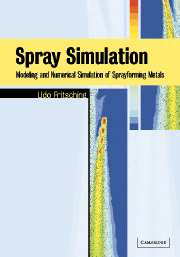2 - Spray forming of metals
Published online by Cambridge University Press: 10 August 2009
Summary
In this chapter, fundamental features of the metal spray forming process are introduced in terms of their science and applications. Chapter 1 saw the division of the process into three main steps:
disintegration (or atomization),
spray establishment, and
compaction.
Now, a more detailed introduction to those subprocesses that are especially important for application within the spray forming process, will be given.
The spray forming process
Spray forming is a metallurgical process that combines the main advantages of the two classical approaches to base manufacturing of sophisticated materials and preforms, i.e.:
metal casting: involving high-volume production and near-net shape forming,
powder metallurgy: involving near-net shape forming (at small volumes) to yield a homogeneous, fine-grained microstructure.
The spray forming process essentially combines atomization and spraying of a metal melt with the consolidation and compaction of the sprayed mass on a substrate. A typical technical plant sketch and systematic scheme of the spray forming process (as realized within several technical facilities and within the pilot-plant-scale facilities at the University of Bremen, which will be mainly referenced here) is illustrated in Figure 2.1. In the context of spray forming, a metallurgically prepared and premixed metal melt is distributed from the melting crucible via a tundish into the atomization area. Here, in most applications, inert gas jets with high kinetic energy impinge onto the metal stream and cause melt disintegration (twin-fluid atomization). In the resulting spray, the droplets are accelerated towards the substrate and thereby cool down and partly solidify due to intensive heat transfer to the cold atomization gas.
Information
- Type
- Chapter
- Information
- Spray SimulationModeling and Numerical Simulation of Sprayforming metals, pp. 6 - 20Publisher: Cambridge University PressPrint publication year: 2004
